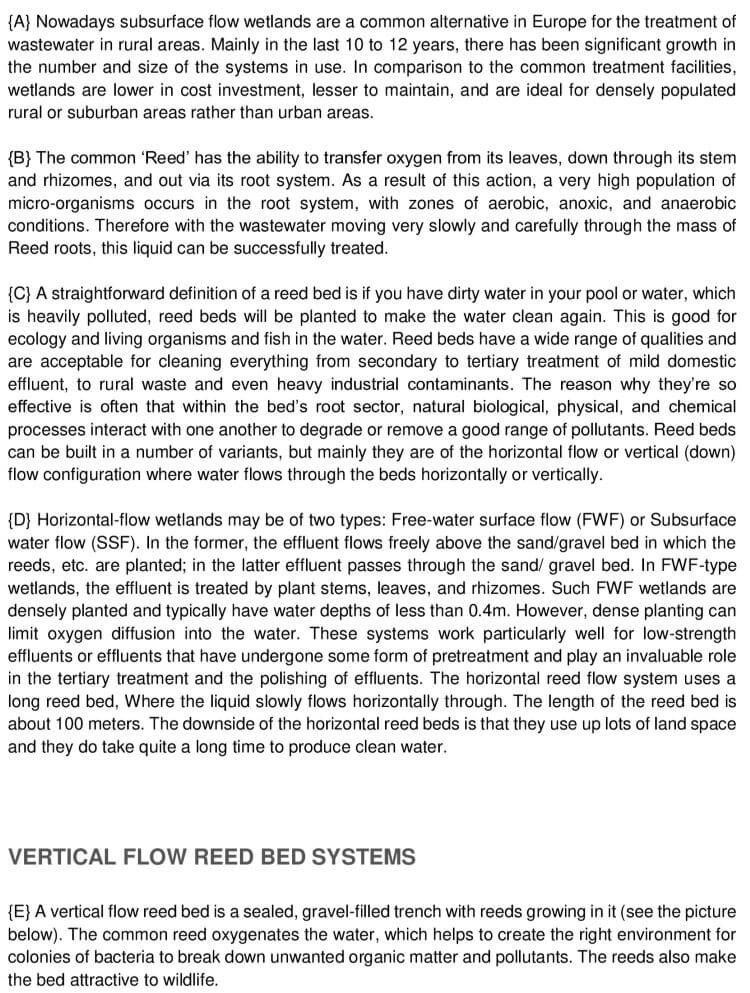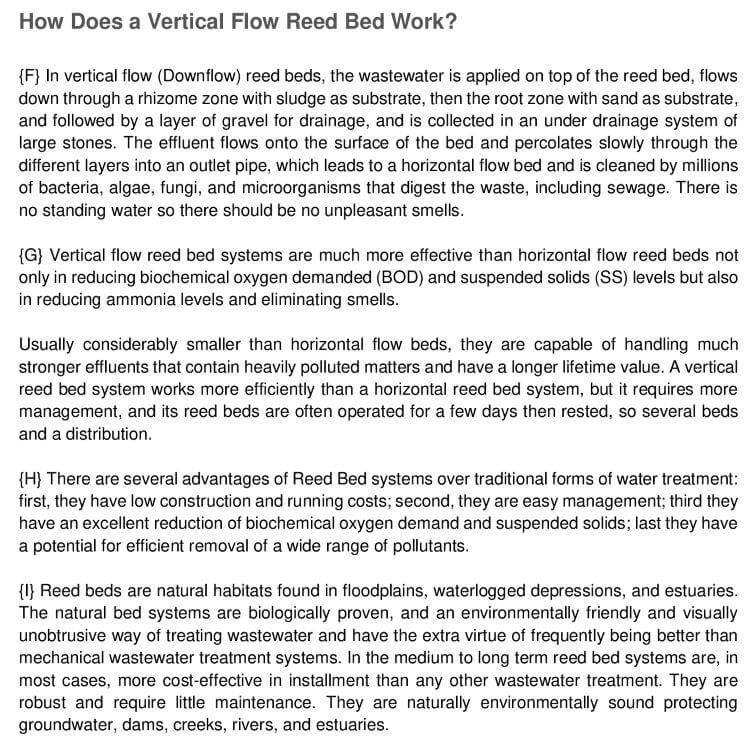Reed Bed IELTS Reading Answer
8 min read
Updated On
-
Copy link
Need help with Reed Bed IELTS Reading Answers? Discover detailed explanations, tips, and expert insights to enhance your reading skills and ace the test!
Table of Contents

Limited-Time Offer : Access a FREE 10-Day IELTS Study Plan!
Reed Bed is a reading passage from IELTS reading test, making it ideal for IELTS Academic Reading preparation. Ideally, you should not spend more than 20 minutes while practicing this passage. If you want more practice, try taking an IELTS reading practice test. With practice you would be able to do well in your IELTS Reading exam and score higher IELTS Band Score!
Reading Passage
Reed Bed


Questions 1-3
Do the following statements agree with the information given in IELTS Data Reading Passage 128 – Water Treatment 2: Reed Bed Passage?
In boxes 1-3 on your answer sheet, write
True If the statement is true.
False If the statement is false
Not Given If the information is not given in the passage.
Question 1. The Reed bed system is a conventional method for water treatment in an urban area.
Question 2. IN the reed roots, there’s a series of process that helps break down the pollutants.
Question 3. Escherichia coli is the most difficult bacteria to be dismissed.
Questions 4-6

Questions 7-11
………7…………, which is the advantage of the down-flow system. However, ………..8………. and ……….9……… are the disadvantages of the down-flow system.………10………and ……..11………….. are the two benefits of the horizontal flow system. However, it’s less effective and efficient.
[A] It can deal with a more seriously polluted effluent.
[B] It requires more beds than one compared to the other.
[C] It needs less control and doesn’t need to be taken care of all the time.
[D] It requires a lot of guidance.
[E] It can’t work all the time because the pool needs time to rest and recover after a certain period.
[F] It’s a lot more complicated to build the system.
[G] The system is easy to be built and does not need an auxiliary system.
[H] It consumes less water.
Questions 25-26
Choose two correct letters from the following A, B, C, D, or E.
Write your answers in boxes 12-13 on your answer sheet.
What are the two benefits of natural bed systems when compared to conventional systems?
[A] Operation does not require electricity or fuel supply.
[B] They’re visually good and environmentally friendly.
[C] No mechanical systems are involved.
[D] They’re to be set up and used at less cost.
[E] They do not break down.
Reed Bed Reading Answer Explanation
14 Answer: False
Question type: True/False/Not Given
Answer location: Paragraph A, last line
Answer explanation: The last line of paragraph A states that the conventional mechanism of water purification used in big cities where there are large volumes of water to be purified is inappropriate in rural areas. We can understand from these lines that the reed bed system is a conventional mechanism of water purification method used in big cities (urban areas), where there’s a huge volume of water to be purified. Thus, the statement agrees with the information, so, the answer is True.
15 Answer: True
Question type: True/ False/ Not Given
Answer location: Paragraph B, last line
Answer explanation: The last line of paragraph B states the reason why they are so effective is often that within the bed’s root sector, natural biological, physical, and chemical processes interact with one another to degrade or remove a good range of pollutants. We can deduce from these lines that the reed bed system is effective as within the bed’s toot sector, the natural biological, physical, and chemical processes interact with one another helping break the pollutants. Thus, the statement agrees with the information, so, the answer is True.
16 Answer: Not Given
Question type: True/False/ Not Given
Answer location: Paragraph E
Answer explanation: We find a reference for Bacteria in Paragraph E, where it is mentioned that the common reed oxygenates the water, which helps to create the right environment for colonies of bacteria to break down unwanted organic matter and pollutants. These lines suggest that the reed oxygenates the water, helping to create the right environment for the bacterial colonies to break down unwanted organic matter and pollutants. As a result, there’s no mention of Escherichia coli in the passage. So, the answer is Not Given.
17 Answer: Sludge
Question type: Diagram Completion
Answer location: Paragraph F
Answer explanation: Paragraph F illustrates that in vertical flow (Downflow) reed beds, the wastewater is applied on top of the reed bed, and flows down through a rhizome zone with sludge as substrate. So, according to the downflow reed bed system, the sludge is used as a substrate. Thus, the answer is sludge.
18 Answer: Sand
Question type: Diagram Completion
Answer location: Paragraph F
Answer explanation: Paragraph F illustrates the theory of the downflow reed bed system, that in vertical flow (Downflow) reed beds, the wastewater is applied on top of the reed bed, flows down through a rhizome zone with sludge as substrate, then the root zone with sand as a substrate. We understand that the downflow occurs with the rhizome zone with sludge as substrate followed by the root zone with sand. So, the answer is sand.
Book a FREE Online Webinar with Our IELTS Experts to Learn More Tips and Techniques for IELTS Reading!
19 Answer: gravel
Question type: Diagram Completion
Answer location: Paragraph F
Answer explanation: Paragraph F states the theory of downflow of the reed bed system, where the wastewater is applied on top of the reed bed, flows down through a rhizome zone with sludge as substrate, then the root zone with sand as substrate, and followed by a layer of gravel for drainage, and is collected in an under drainage system of large stones. We can deduce that after applying wastewater on the top of the reed bed, it flows down through a rhizome zone with sludge as substrate, followed by a root zone with sand and a layer of gravel for drainage, which is then collected in an under drainage system of large stones. Thus, the answer is gravel.
20 Answer: A
Question type: Matching Information
Answer location: Paragraph H
Answer explanation: The last line of paragraph H reveals that the reed bed systems have the potential for the efficient removal of a wide range of pollutants. We know from the reading passage that Reed Beds will clean up the polluted water, which is simply good for the ecology and living organisms and fish in the water. Further, its mentioned in paragraph H that it has the potential to remove a wide range of pollutants efficiently. Thus, the answer is A.
21 Answer: B
Question type: Matching Information
Answer location: Paragraph D, last line
Answer explanation: The last line of paragraph D states that the horizontal reed flow system uses a long reed bed, Where the liquid slowly flows horizontally through. The length of the reed bed is about 100 meters. The downside of the horizontal reed beds is that they use up lots of land space and they do take quite a long time to produce clean water. We can understand from these lines that Reed beds use a large space as their length is about 100 meters, as a result of which, it requires more than one reed bed and it also takes up quite a long time to produce clean water. Thus, the answer is B.
22 Answer: E
Question type: Matching Information
Answer location: Paragraph G, last line
Answer explanation: The last line of paragraph G illustrates that a vertical reed bed system works more efficiently than a horizontal reed bed system, but it requires more management, and its reed beds are often operated for a few days then rested, so several beds and a distribution. These lines indicate that the horizontal reed bed system is more efficient than vertical reed beds as they require more management and are operated for a few days after a rest, i.e the reed beds can’t work all the time because the pool needs some time to rest and recover after a period. Thus, the answer is E.
23 Answer: C
Question type: Matching Information
Answer location: Paragraph I, line 7
Answer explanation: The 7th line of paragraph I illustrates that the long-term reed bed systems are, in most cases, more cost-effective in installment than any other wastewater treatment. They are robust and require little maintenance. We can understand from these lines that the reed bed systems exhibit great strength (robust) and require less control (maintenance). Thus, the reed bed systems need less control and don’t need to be taken care of all the time because they’re of great strength. Sl, the answer is C.
24 Answer: G
Question type: Matching Information
Answer location: Paragraph H
Answer explanation: We can understand from paragraph H that there are several advantages of Reed Bed systems, one of which is that they have low construction and running costs and are easy management. These lines indicate that Reed Bed Systems doesn’t need an additional system (auxiliary system) to be built effectively. Therefore, the answer is G.
25 Answer: B
Question type: Multiple Choice Question Answer location: Paragraph I, line 2
Answer explanation: The 2nd line of paragraph I states that the natural bed systems are biologically proven and an environmentally friendly and visually unobtrusive way of treating wastewater. These lines indicate that Reed bed systems are proven biologically and are environmentally friendly and visually good. Thus, the answer is B.
26 Answer: D
Question type: Multiple Choice Question
Answer location: Paragraph I
Answer explanation: Paragraph I illustrates that the Reed Bed systems in most cases are more cost-effective in installment than any other wastewater treatment systems. We can deduce from these lines that the installation of reed bed systems is extremely inexpensive than other treatment systems. So, the answer is D.
Seeking IELTS Reading Advice? Sign up with IELTS Experts to Boost Your IELTS Reading Skills!
Check More IELTS Reading Answers
Practice IELTS Reading based on question types

Start Preparing for IELTS: Get Your 10-Day Study Plan Today!
Recent Articles

Nehasri Ravishenbagam

Haniya Yashfeen

Haniya Yashfeen

Haniya Yashfeen




Post your Comments